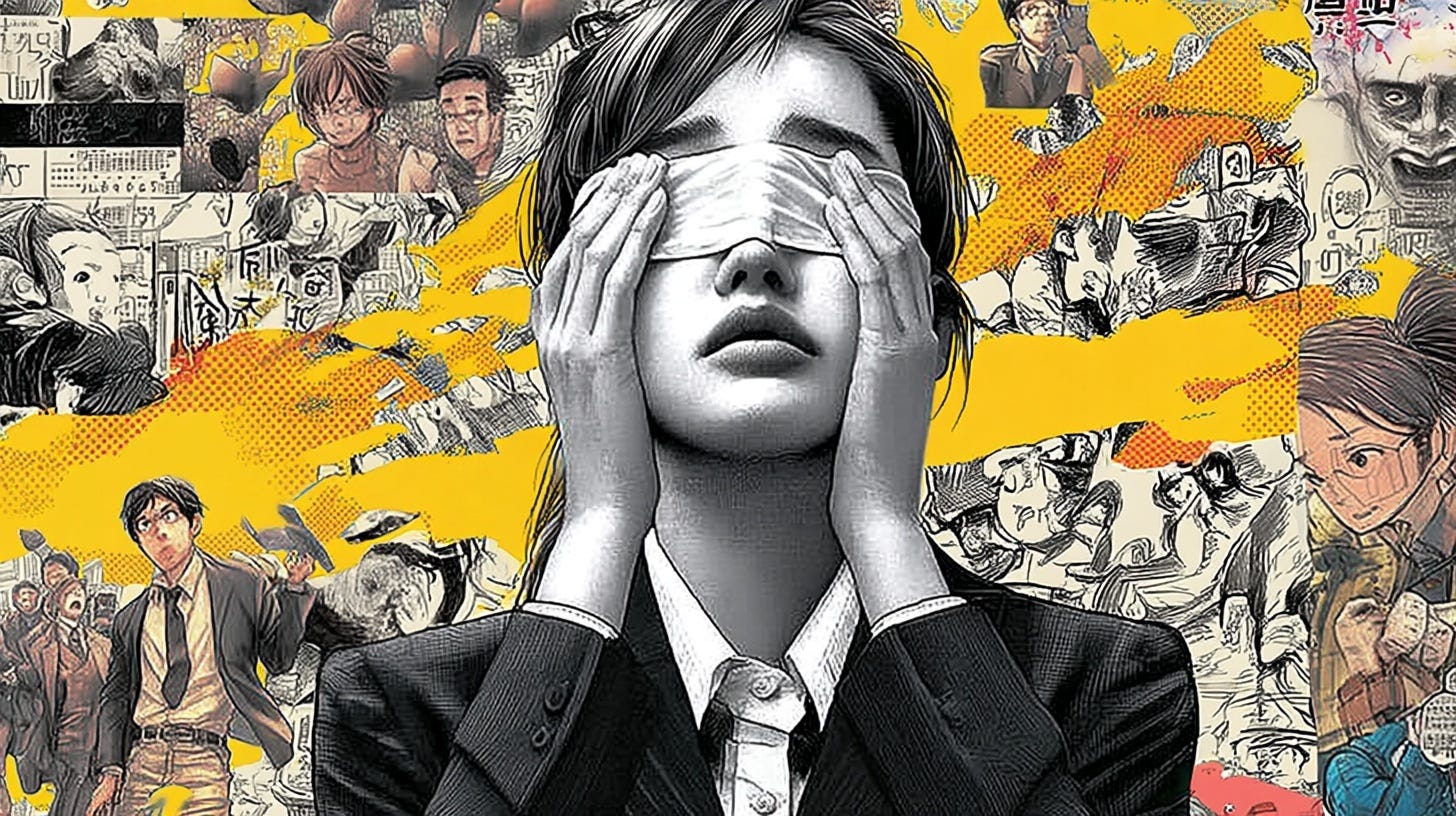Unfinished Business and the Bandage
Why having the courage to properly hold our grief can be the start of true healing
In daily life, we collect scrapes, cuts, and bruises—small reminders of how fragile the body can be. A cut finger in the kitchen. A knee scraped on wet pavement. A tumble after returning to an old sport. The healing is straightforward: wash the wound, cover it, give it care and time.
But sometimes, we forget. We leave the scrape untended. We keep a bandage on too long, ignoring the festering that is going on underneath.
What about the wounds we cannot see?
How often do we bandage our emotional pain—convincing ourselves that if we just wait long enough, it will heal on its own? In protecting ourselves from discomfort, might we also be turning away from the very process that leads to healing?
This reminds me of a moment with my friend, Ayako,* that remains forever engraved in my mind.
Unfinished Business — What Are Unfinished Emotions?
The text message came out of nowhere on a Tuesday afternoon.
“Want to grab a drink after work?“
It was from Ayako, a friend whose career trajectory had always impressed me. Her LinkedIn profile read like a master class in leadership success—steady promotions, impressive results, the kind of upward momentum that made her seem unstoppable. By every external measure, she was winning.
But the moment I saw her face that evening, I knew something had shifted.
“You look exhausted,” I said, settling into the chair across from her. “Everything okay?”
She stared into her drink for a long moment. “I don’t know. There’s something really off in my life, and I can’t seem to shake it.”
What came next caught me completely off guard.
“Each time I get a promotion or move up to a bigger title with better pay, I feel this rush of relief—like I’ve finally proven myself. But then...” She paused, searching for words. “It all starts over again.”
“Like you’re stuck in something,” I offered.
“Exactly. There’s this voice that never stops. This deeper sense that I’ll never be enough. That I’m not enough. So I keep pushing, keep proving I’m worthy of whatever comes next.”
I studied her face, trying to reconcile this vulnerability with the confident leader I thought I knew. “I never would have imagined you felt this way. You always seem so together.”
That’s when the dam broke.
“The thought that ‘I am not enough’ has been with me since childhood,” she said, her voice barely above a whisper. “I have almost no memories of being praised by my parents. My siblings were, but not me—not for grades, not for anything. I never felt accepted. So I internalized this drive: ‘I’m not enough. I have to do more.’ Even when I accomplish something, the self-criticism doesn’t stop—’I should have done better’ or ‘I could have handled that differently.’ And the worst part? I end up imposing this same impossible standard on everyone around me, which destroys my relationships. I’ve been trapped in this cycle for decades—beating myself up and beating others up, hoping that somehow, someday, I’ll finally be enough.“
I sat there, stunned.
In that moment, I witnessed something rare and courageous—someone pulling back the curtain on the gap between their public success and private struggle—between their “fitting-in self” and their “authentic self.” And from the pain in Ayako’s eyes it was clear that acknowledging these unresolved emotions had been no easy task.
Cost of Avoidance—The Price of Not Looking
In psychology, unresolved emotions like Ayako’s are colloquially referred to as “unfinished business”. In every life, there are matters left unresolved—like wounds kept beneath a bandage. No matter how stellar a career we build, nothing truly heals until we face these emotions and the patterns they create within us. When we fail to do this, they return to us, again and again.
After talking with Ayako, I couldn’t stop thinking about what happens when we cannot “properly hold our grief,” and instead slap on a bandage and get by with first aid. Gestalt therapy founder Fritz Perls wrote that unfinished business is any unexpressed emotion from the past that interferes with present awareness. Ayako’s fears—“I am not good enough,” “I won’t be accepted as I am”—are emotions born of her interpretations. Those emotions are certainly “real.” But were the interpretations that produced them actually true?
When we keep a bandage on and choose not to look at an emotional wound, it comes back over time larger, stronger, and deeper. Psychologist Bluma Zeigarnik showed experimentally that unfinished tasks are remembered more strongly than completed ones, which is referred to as the Zeigarnik effect (McLeod, 2023). Much like multiple browser tabs saved as “I’ll read this later” that continue to consume memory in the background, unfinished emotions quietly drain our energy.
Psychologist Mark Travers notes that when unresolved elements remain, we tend to replay past events and imagine counterfactual outcomes, falling into repetitive thought patterns that are emotionally exhausting (Travers, 2024). When we’re depleted like this, can we really perform as expected? Rather than nurturing healthy self-regard, might we be damaging our confidence?
There are times when it is necessary to hold emotions gently and leave them be. Even so, facing the truly important unfinished emotions is what ultimately helps us live better—both as professionals and as human beings.
Moving Toward Healing—A Step-by-Step Process for Healing
So how do we remove the bandage from the heart and begin the healing process?
Travers discusses this primarily in the context of romantic relationships, but the steps he offers can also be helpful when working with emotions more broadly (Travers, 2024). They are presented below as starting points for your journey. Ultimately, each step can be be reflected upon in depth. Exploring them through journaling or with the aid of a trained coach or therapist could help you gently open the door to the healing process.
1. Acknowledge that unfinished emotions exist
Acknowledge that there are unresolved emotions or experiences. Recognize what weighs on you and which feelings remain unfinished.
2. Accept ambiguity
Accept that not everything around us is logical. Not everything has a clear answer. Cultivate the capacity to live with unanswered questions—Negative Capability. (Please also read my article, Leading Like Bamboo, where I discuss negative capability.)
3. Feel and put it into words
Express what you wanted to say, what you wanted to do, what you felt, what you are feeling now, and what you learned from the event.
4. Forgive
Mark an end to the negative emotions directed toward yourself or others.
5. Let go
Create closure through your own small ritual of mourning—write a letter and tear it up, place symbolic items in a box, etc.
6. Make time to heal
Allow time for the wound to heal, and treat yourself with care. Recovery is not linear. Be kind to yourself.
Reflection:
What is your “open tab” in your heart right now?
Choose one. If you were to take two of the six steps above today, which would you begin with?
Unfinished business exists for everyone. Looking away does not make it disappear; if anything, the more we avert our eyes, the more strongly it remains and the more it returns in new forms.
A series of kind acts towards ourselves sends us forward into the future with lightness. It all begins with a small act of courage—like peeling off a single bandage.
In my next article, I’d like to continue this exploration of unfinished business by looking at the signals it sends to our body before our “mind” starts to notice that something is really off.
* To ensure confidentiality, I’ve used the pseudonym “Ayako.”
References
McLeod, S. (2023). Zeigarnik Effect Examples in Psychology. SimplyPsychology. https://www.simplypsychology.org/zeigarnik-effect.html
Travers, M. (2024). 3 Reasons Behind Love’s ‘Zeigarnik Effect’—By A Psychologist. Forbes.com. https://www.forbes.com/sites/traversmark/2024/12/23/3-reasons-behind-loves-zeigarnik-effect-by-a-psychologist/





